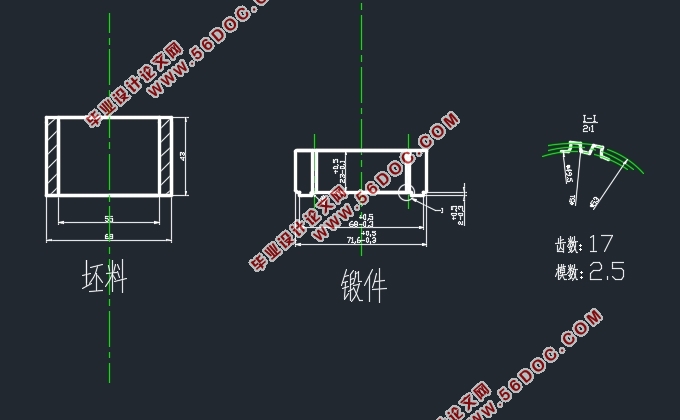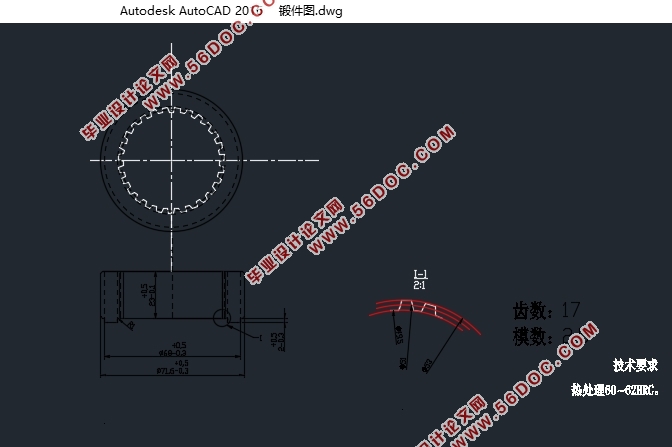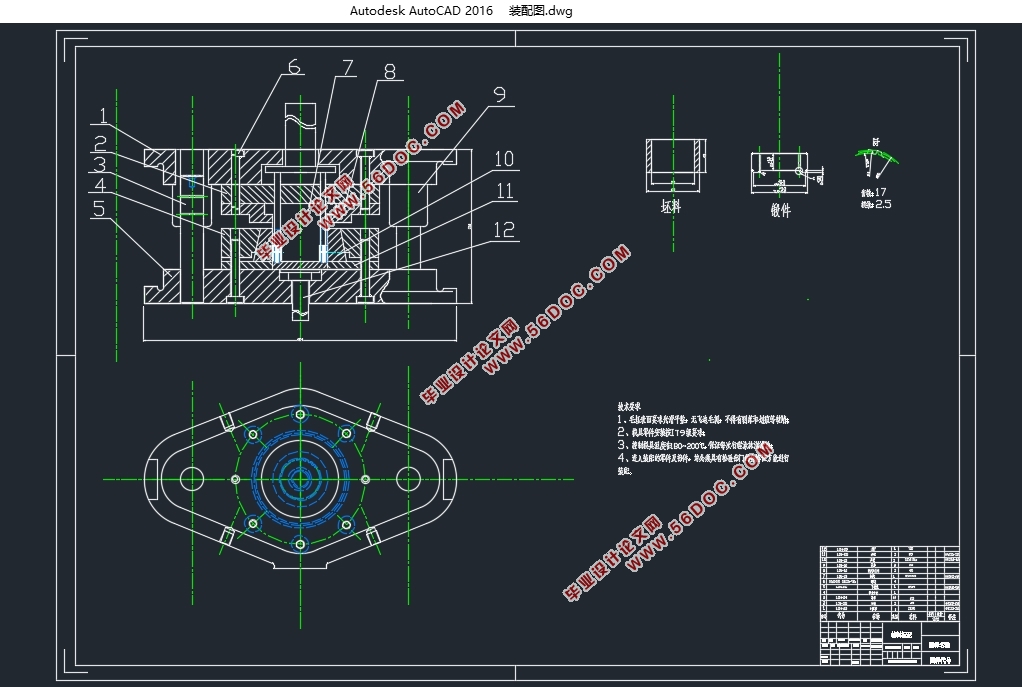同步器定位外环成形工艺与模具设计(含CAD零件图装配图)
来源:56doc.com 资料编号:5D22107 资料等级:★★★★★ %E8%B5%84%E6%96%99%E7%BC%96%E5%8F%B7%EF%BC%9A5D22107
资料以网页介绍的为准,下载后不会有水印.资料仅供学习参考之用. 密 保 惠 帮助
资料介绍
同步器定位外环成形工艺与模具设计(含CAD零件图装配图)(任务书,开题报告,论文说明书10400字,CAD图5张)
摘要
同步器定位外环是汽车同步器中的重要零件,其强度要求好,尺寸精度要求高。由于传统的切削加工破坏了金属的纤维流线,导致疲劳寿命和轮齿强度不够同时材料利用率低、成本高。采用热锻加工方法成形零件,定位外环的锻件设计(其加工余量是5%)、模锻成形参数,如锻造温度,挤压速度等和热锻模具的设计最终得到了符合要求的锻件。主要研究工作为成形模具优化、数值模拟实验规律总结以及装配图的绘制。通过研究得出:当使用环形坯料时,对坯料的厚度和高度也有所要求。坯料的高度太小时容易发生齿顶不容易填充饱满的情况。所以选择合适的坯料尺寸对整个成型质量有很大的影响。
关键词:同步器定位外环,热锻,数值模拟,模具
Abstract
The synchronizer positioning ring is an important part in the automobile synchronizer, the strength requirement is good, high precision. Due to the destruction of the traditional machining metal fibre flow, resulting in the fatigue life and the fatigue strength of gear tooth is not at the same time the material utilization rate is low, the cost is high. The precision forming method is an effective way to solve these problems this method is used. The forging of ring billet forging design, positioning ring, forging parameters and hot forging die design to meet the requirements of the final forging. Main research work for the optimization of forming die, numerical simulation experiment and summarizes rules of assembly drawings are drawn. The result shows that when the use of the ring the blank, the blank thickness and height will be required. The blank of moderate height can avoid folding. The blank height is too prone to hours of tooth top is not easy to fill full So it has a great influence on the forming quality of the whole forming quality by selecting the appropriate blank size.
Key words: synchronizer positioning ring, numerical simulation experiment,forming quality
环类零件塑性成形有多种方式,定位外环的成形可采用厚壁管镦粗成形工艺,如图,为保证零件成形过程顺利,对金属塑性成形原理的应力-应变关系,材料流动理论等进行探讨分析。




目录
第一章 概论
1.1引言•••••••••••••••••••••••••••••1
1.2课题的主要内容••••••••••••••••••••••••1
1.3设计同步器定位外环的目的和意义••••••••••••••••1
1.4 环类零件成形的现状及发展趋势•••••••••••••••••2
第二章 成型的基本理论
2.1基本分析方法•••••••••••••••••••••••••3
2.2影响闭式模锻件尺寸精度的主要因素•••••••••••••••4
2.3塑性成形中的基本问题•••••••••••••••••••••5
2.3.1最小阻力定律•••••••••••••••••••••••5
2.3.2影响金属塑性的因素••••••••••••••••••••5
2.3.3附加应力与残余应力对塑性的影响••••••••••••••6
2.4 同步器定位外环精锻成形三维数值模拟
2.4.1实体模型的建立•••••••••••••••••••••6
2.4.2有限元模型的建立••••••••••••••••••••7
2.4.3 模拟流程••••••••••••••••••••••••8
2.4.4模拟条件及参数的选择 ••••••••••••••••••8
2.4.5模拟结果与分析•••••••••••••••••••••9
第三章 同步器定位外环精锻工艺设计
3.1锻件设计•••••••••••••••••••••••••••11
3.2坯料设计•••••••••••••••••••••••••••12
3.3实验模具关键零件设计
3.3.1凸模的设计•••••••••••••••••••••••13
3.3.2凹模的设计•••••••••••••••••••••••14
3.4主要的辅助工序
3.4.1坯料和锻件的清理••••••••••••••••••••14
3.4.2锻件的后处理••••••••••••••••••••••15
3.4.3加热设备的选择与加热规范的制定•••••••••••••15
3.4.4润滑剂的选择••••••••••••••••••••••16
3.4.5关于加热过程产生的问题•••••••••••••••••17
3.5精锻成形力的计算和设备型号选择••••••••••••••••17
第四章 总结•••••••••••••••••••••••••••••19
4.1全文总结••••••••••••••••••••••••••••19
4.2研究展望••••••••••••••••••••••••••••19
致谢•••••••••••••••••••••••••••••••••21
参考文献•••••••••••••••••••••••••••••••23
|









